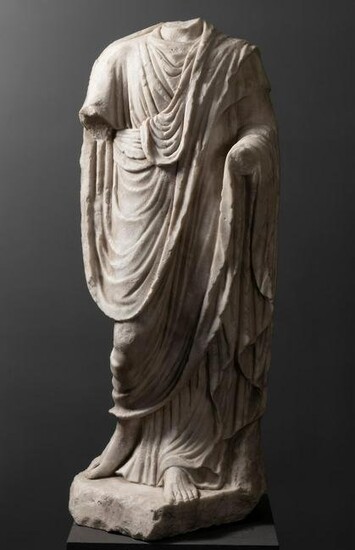Figure; High-Imperial Roman art, 1st-2nd centuries AC
Figure in robes; High-Imperial Roman Art, 1st-2nd century AD.
White marble.
It has a French export permit.
It presents damages caused by the passage of time.
Measurements: 105 cm.
Roman toga represented standing, with a tunic and over it a toga, the most characteristic garment of the Roman civilisation. The figure is shown standing upright, with a slight contrapostto, with his left hip slightly prominent, resting his weight on his left leg while his right leg is slightly bent, in a resting position. In this elegant headless figure, the position turns slightly to the right, with the right foot turned to the left. The robe is partially covered by the toga and crosses the silhouette diagonally, creating deep folds and thus an attractive light-dark effect and density in the drapery.
The toga, made of wool or other materials, was considered a sign of high social and economic status, reserved for the Roman elite. At the end of the 1st century BC, the toga declined in use, but under Augustus it came back into fashion as a symbol of the revitalisation of the customs and values of Roman society. Large and heavy, the toga gave a solemn appearance to those who wore it, it supported and represented well the importance of Rome, ruler of the ancient world.
High Empire is the name usually given to the first half of the historical period covered by the Roman Empire, comprising its heyday, at the height of the expansion of the slave mode of production and of all expressions of classical civilisation, under the system of government known as the Principate as established by Octavian Augustus at the end of the 1st century BC, up to the dynasty of the Severi. Territorial expansion (already characteristic of the Republican period) continued de facto (annexation of border areas in direct contact with the barbarian peoples and the Parthian Empire), although in theory expressed under concepts of containment and consolidation rather than aggressiveness (Pax Romana, limes).
The progressive extension of Roman citizenship throughout the provinces, as they became Romanised, included the promotion of provincial families to the highest honours and social ranks, even to imperial dignity. The transformation was undergone throughout the Mediterranean basin, but with notable differences in the western (more Latinised) and eastern halves (where Hellenistic influence continued and even deepened).
After the Empire reached its maximum territorial dimensions at the time of the Antonines (2nd century), the crisis of the 3rd century opened a period of decline that allows us to speak of the Lower Roman Empire, with other economic and social conditions (the transition from slavery to feudalism), and even with another system of government (the Dominate).
Estimate
Time, Location
Auction House
Figure in robes; High-Imperial Roman Art, 1st-2nd century AD.
White marble.
It has a French export permit.
It presents damages caused by the passage of time.
Measurements: 105 cm.
Roman toga represented standing, with a tunic and over it a toga, the most characteristic garment of the Roman civilisation. The figure is shown standing upright, with a slight contrapostto, with his left hip slightly prominent, resting his weight on his left leg while his right leg is slightly bent, in a resting position. In this elegant headless figure, the position turns slightly to the right, with the right foot turned to the left. The robe is partially covered by the toga and crosses the silhouette diagonally, creating deep folds and thus an attractive light-dark effect and density in the drapery.
The toga, made of wool or other materials, was considered a sign of high social and economic status, reserved for the Roman elite. At the end of the 1st century BC, the toga declined in use, but under Augustus it came back into fashion as a symbol of the revitalisation of the customs and values of Roman society. Large and heavy, the toga gave a solemn appearance to those who wore it, it supported and represented well the importance of Rome, ruler of the ancient world.
High Empire is the name usually given to the first half of the historical period covered by the Roman Empire, comprising its heyday, at the height of the expansion of the slave mode of production and of all expressions of classical civilisation, under the system of government known as the Principate as established by Octavian Augustus at the end of the 1st century BC, up to the dynasty of the Severi. Territorial expansion (already characteristic of the Republican period) continued de facto (annexation of border areas in direct contact with the barbarian peoples and the Parthian Empire), although in theory expressed under concepts of containment and consolidation rather than aggressiveness (Pax Romana, limes).
The progressive extension of Roman citizenship throughout the provinces, as they became Romanised, included the promotion of provincial families to the highest honours and social ranks, even to imperial dignity. The transformation was undergone throughout the Mediterranean basin, but with notable differences in the western (more Latinised) and eastern halves (where Hellenistic influence continued and even deepened).
After the Empire reached its maximum territorial dimensions at the time of the Antonines (2nd century), the crisis of the 3rd century opened a period of decline that allows us to speak of the Lower Roman Empire, with other economic and social conditions (the transition from slavery to feudalism), and even with another system of government (the Dominate).



